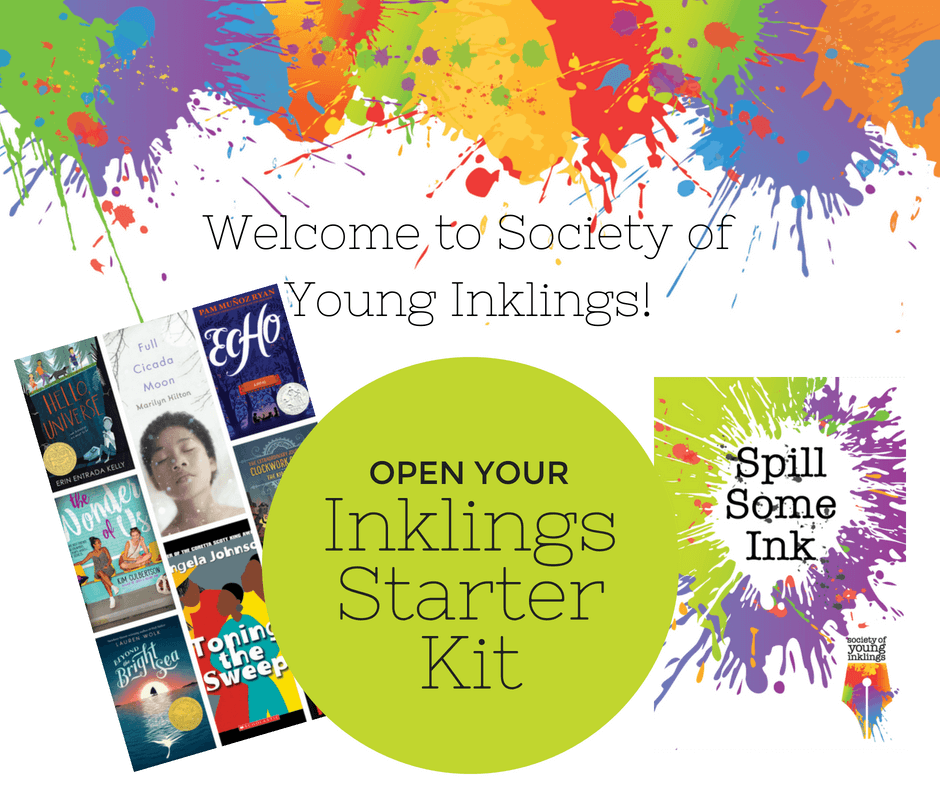For December’s Ink Splat, we spoke to Margaret Chiu Greanias about her picture book Amah Faraway which is written as a reverse poem. A reverse poem is a poem that can be read forwards to have one meaning and backwards to have another. Margaret talks to us more about that process and also gives us an in-depth writing challenge to help us write our own reverse poems!
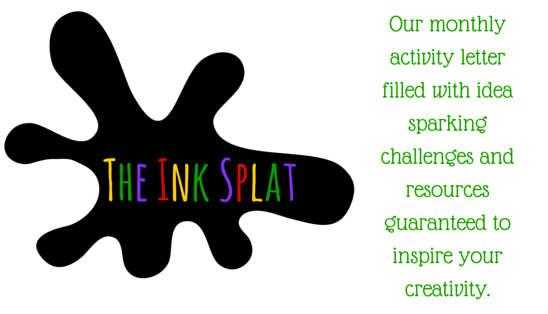
Writing Challenge
from Margaret Chiu Greanias
Before I wrote my picture book AMAH FARAWAY, I had never written a reverse poem. While awed by reverse poems I had read online, I wasn’t sure I could write one myself. I started with one line, played, and used trial and error until I had a story!
Try writing reverse poem. The poem will express different points of view/attitudes. It can be as short as two lines or as many lines as you choose.
- Pick a topic that you have opposite/conflicting feelings about. Ideas include a season like winter, school, a sibling, sleep, the dark, etc.
- Brainstorm words, phrases, opinions you associate with your topic.
- Piece together your words, phrases, opinions into a poem that expresses a tone or opinion.
- Read it top to bottom and bottom to top.
In many reverse poems, general lines are sandwiched by negative or positive lines. For example:
| Winter is fun. It is not true that snow ruins everything. |
Snow ruins everything. It is not true that winter is fun. |
Other general lines include: I tell you this, it is plain to see / it is not plain to see, I will never believe that / I believe that, in the future, is more important than, I do not agree that, are greater than/ are less than, it’s wrong that/it’s not wrong that, people should believe that/people should not believe that, it is not true that/it is true that, I don’t doubt that, I believe that/I will never believe that, it is not true that/it is true that, there is no way that
Tips:
- You can write each line on a notecard so you can easily shift the order
- You can break up the lines in different ways, even making them as short as 1-word long
Most importantly, play! This is all about trying things and seeing if they work. You’ll learn as you go.
Advanced tools: point of view, punctuation, phrasing, word choice, synonyms, context. Here are some examples:
Point of View:
| Amah showed her the city she loved. |
She loved the city Amah showed her. |
Synonym/Context:
| Ten twelve-person tables and over nine courses of steaming food! GULP! Kylie ate… rice. Finally. |
Finally, Kylie ate rice… GULP! and over nine courses of steaming food! Ten twelve-person tables– |
Punctuation:
| Kylie ate… rice. Finally. |
Finally, Kylie ate rice… |
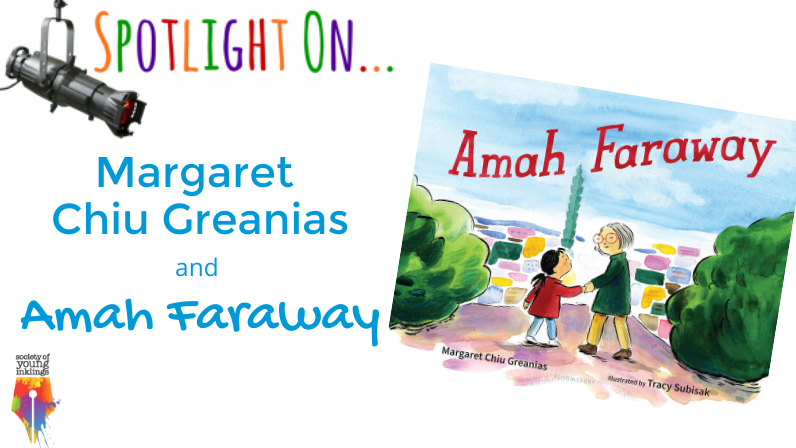
An Interview with Margaret Chiu Greanias
When did you know you wanted to be a writer?
I didn’t want to be a writer as a child because I wasn’t very good at English class. I loved to read. I would bring home stacks of books from the library all the time. But back then, in English class, we didn’t focus on writing stories. So, I wasn’t interested in writing until my last term of my last year of college when I took a creative writing class. I realized that you can write about anything, and it can be really fun. So that’s when I thought that someday, in the future, I want to be a writer. But it wasn’t right away. I became a writer after I had my second child, at age 38. I had, by then, been reading a ton of picture books for my older one, and I realized, Oh, I want to do this.
How were you inspired to write Amah Faraway?
I was inspired in two different ways. One was by my memories of my grandmother who lived far away. I lived in California, and my grandmother lived in Taiwan. So, we didn’t see each other very often. And because I was a shy, cautious kid, every time I did see her, which was pretty rare, once every year or two, there was always this period of getting reacquainted. I would feel shy and a little bit distant from her. And then as the days went on, we would become closer and closer and closer until, by the end, I didn’t want our visit to end.
The other way was by the form. I had read this reverse poem, which is a poem that can be read from the top to the bottom, and also from the bottom to the top. Both ways have different meanings and often different tones. I had heard of that poem before I even became a writer. It made a big impression on me because I didn’t know that that was even possible. Then some time after I started writing, I came across that poem again. I knew then that I wanted to do a story in this form if I could. But I had to find the right concept, where the tone was going to be dramatically different from the first half of this story to the second half. And my grandmother, and these visits with her, were perfect because during the first part I was always very cautious and shy. And then later, I’d be completely opposite. But I didn’t know if I was capable of writing it. So, I started with one sentence, and then went from there and eventually worked it all out!
Tell us more about that process.
I worked on both directions of the story at the same time. So, as I was writing, I was making sure that the poem was going to work forwards and backwards. It actually made it easier in a way because when I thought, Okay, I’m halfway done, I realized, No, no, I’m all the way done!
In the beginning, it was all on scrap paper, and a little scratch notebook. It was just trying it out, line after line after line, to see if it would work. And then once I got it to a point where I thought, Okay, this could be a draft, then I put it in the computer and played with it that way.
How do you work with word choice for your stories?
Word choice is really important as a picture book writer because picture books are around 500 words (nowadays averaging shorter–between 200 to 400 words) to tell a whole story. You do have illustrations, which makes it slightly easier. But you have to be intentional with your words, every word has to work for the story.
The first thing that I do when I write my draft though is work on the big picture. What is the story about? What message do I want to leave the reader with? Who is the story about? What’s their problem? How are they going to solve it? Why is it important that they solve it, things like that–the big picture things.
Once I have a draft, I will actually look at the words because it’s so important to be specific. For example, there’s a big difference, even though they’re kind of synonyms, between jump and hop and leap, or cry and wail and tear up. It tells you a lot about what’s going on and what the character is feeling. If I’m having trouble thinking of a very specific word, I’ll go to thesaurus.com. I use it all the time. I will look up a word, and they have pages and pages of synonyms. I will look through every single page and read every single word and see if it matches what I’m trying to convey. Sometimes, I’ll even look at synonyms of synonyms. I really dig into that site because it’s so important to choose the right specific word.
When you put together the words, is there a way that you assess if they’re having the emotional effect that you desire?
That’s a really good question. Because when you spend a lot of time writing something, it does become hard to be an objective judge of it. There are a few things I can do. One is I read my work aloud. I find that, if I’m just reading in my head, my brain will skim. It will skip over things it thinks I already know. But if I’m forced to read every single word, I can hear if things aren’t working. Another way is I’ll have someone read my work back to me. If there’s no one around, or if I’m feeling shy about sharing my work, I will have Microsoft Word read it to me. It sounds like a computer, which isn’t ideal, but it’s better than nothing. Also, I have several critique groups of trusted writing partners. If I want to know if my work is hitting the right emotional tone, then I can send it to them.
If you feel stuck with something, how do you address that challenge?
Sometimes I have no idea what’s wrong, so I’ll try a lot of different things. One thing I do is go back to the start, not that I throw everything away, but I go back and think, Okay, what am I trying to write? I’ll write up what we call a pitch, a one- to three-sentence summary of the story. That will get to the heart of what I’m trying to get across, and I’ll see if what I wrote matches that pitch.
I will also do story spines. It’s a technique for mapping out a plot. It’s a template that begins with a set up – once upon a time… and then you introduce your character. Every day… which is about what the character does every day. But one day… whatever your inciting incident is that changes your character’s world. And then, because of this, something happens, and because of this, something else happens, and then it just keeps going until, finally, the climax happens. And ever since then… how has life changed for your character after the story? So sometimes I’ll use that because maybe it’ll trigger me to realize, Oh, my plot doesn’t make sense. Because it’s not one thing is causing the next thing is causing the next thing.
If I’m stuck on a character, like a lot of times I get stuck on details, I will do word associations. I’ll put the character’s name in a bubble in the middle, and then draw little lines and bubbles, like this is the family and this is things about the family. And then I’ll do other bubbles, around other characteristics of the character. Other times, I’ll draw pictures because I want to try and flesh out what the character looks like in my mind. Or, I might ask a lot of questions and free write. That may lead to more questions, and I’ll keep freewriting until I have the answer.
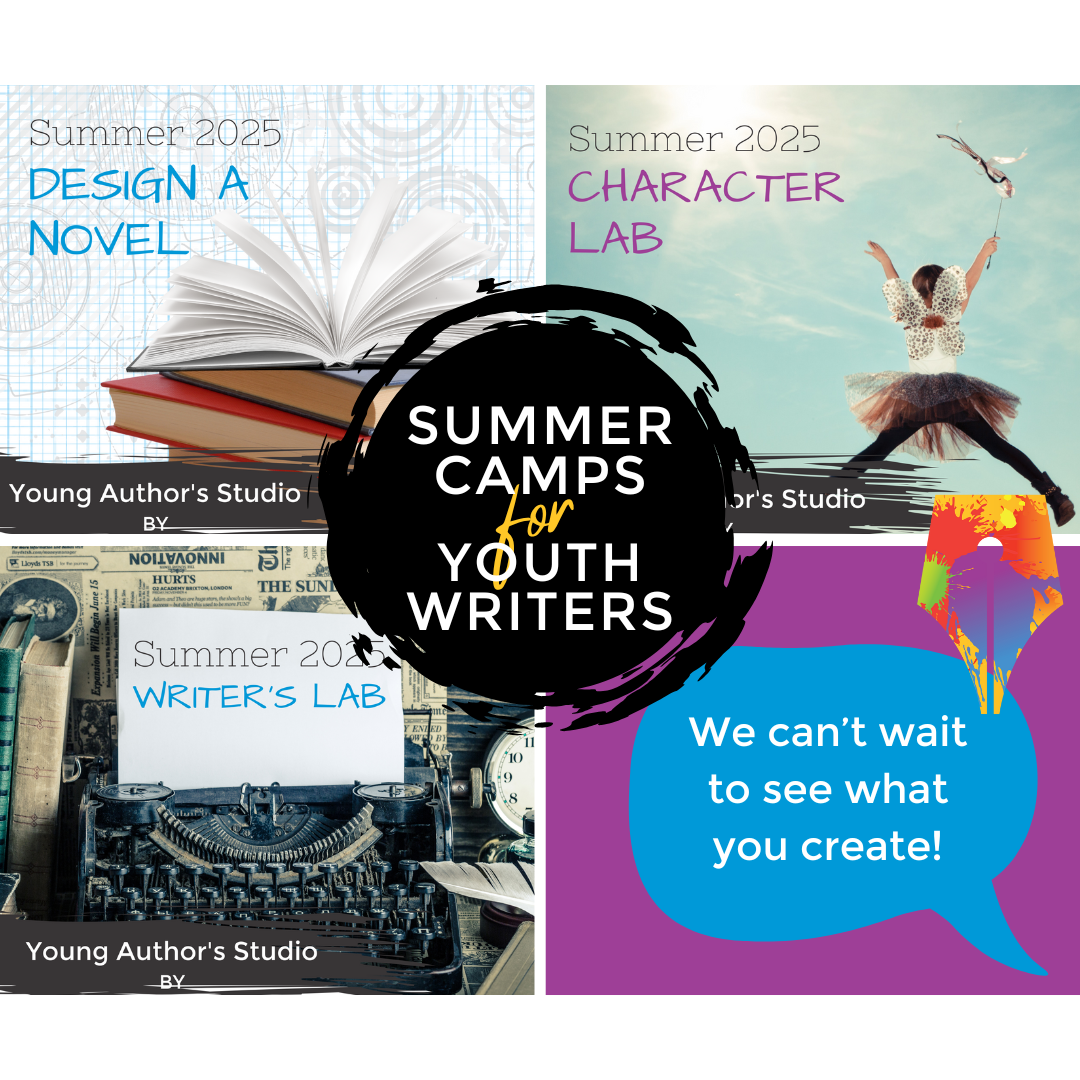
INKLINGS CONNECT
Summer Camps
Join us for a writing camp this summer. We can't wait to see what you create!
Keep your creativity flowing with our upcoming community events:
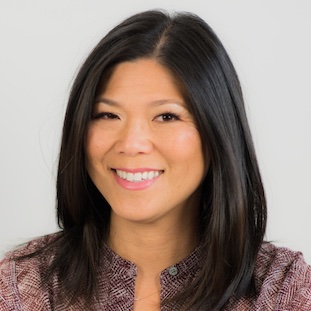
Thank you to Margaret Chiu Greanias for sharing with us! Check out her website at margaretgreanias.com.
Margaret wrote her first terrifically terrible book in fourth grade. From grade school through college, she struggled through her English classes. Then, during her very last quarter of her very last year of college, she took a creative writing class and discovered she loved writing. She is the author of MAXIMILLIAN VILLAINOUS (Running Press Kids, 2018), AMAH FARAWAY (Bloomsbury Kids, 2022), and HOOKED ON BOOKS (Peachtree Publishing, 2023). She currently lives in the San Francisco Bay Area with her husband, three children, and a fluffle of dust bunnies.
SPARK YOUR CREATIVITY!
As a bonus gift, we’ll send you an Inklings Starter Kit packed with creativity-sparking fun.
